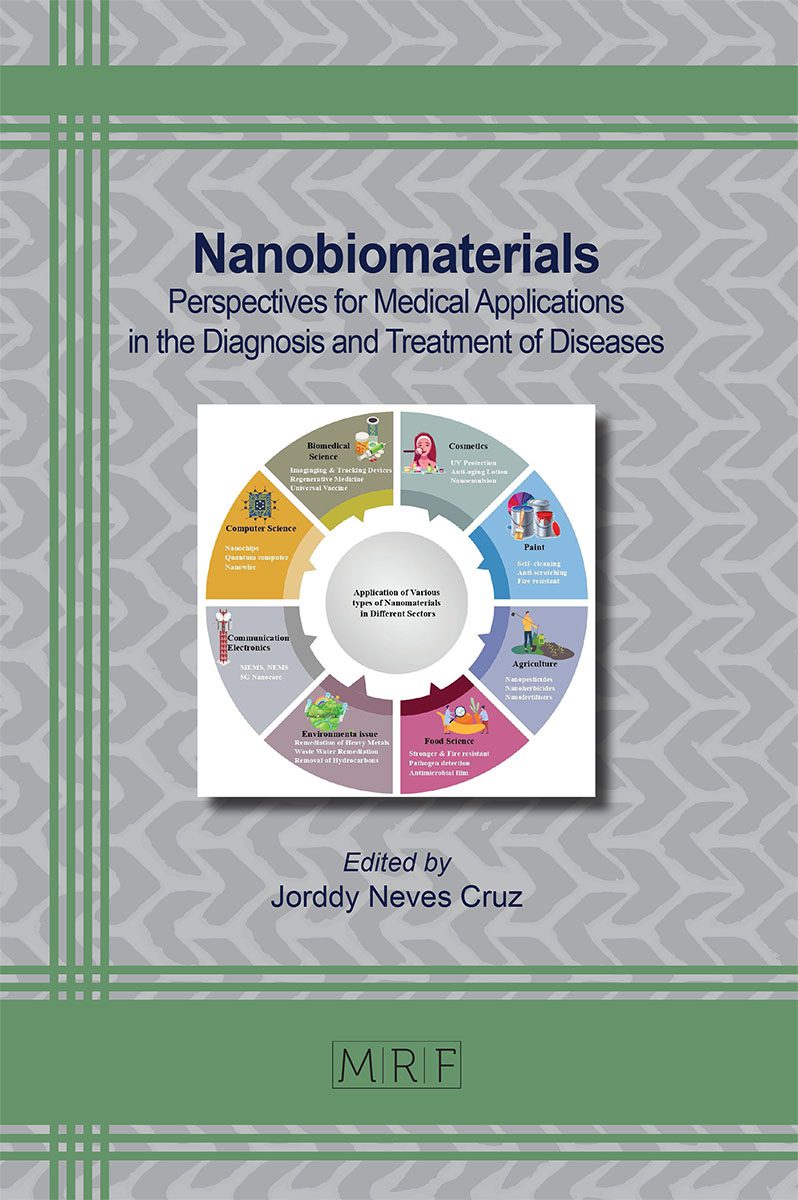Ethics of Nanomedicine
Ineke Malsch
Nanomedicine is the application of nanomaterials and nanotechnologies in healthcare. Nanomedicine is a key enabler of e.g., mRNA COVID-19 vaccines, and enables digital twins, organ on chip and wearables. Introducing nanomaterials in the body in pharmaceuticals or implants raises nanosafety issues. Ethical impacts of nanomedicine are e.g., related to freedom, equality, data protection, and biosecurity. Researchers should contribute to Responsible Research and Innovation together with governments and other stakeholders. The principles of inclusiveness, anticipation, openness and responsiveness are leading.
Keywords
Nanomedicine, Ethics, Responsible Research and Innovation, Nanosafety
Published online , 15 pages
Citation: Ineke Malsch, Ethics of Nanomedicine, Materials Research Proceedings, Vol. 145, pp 311-325, 2023
DOI: https://doi.org/10.21741/9781644902370-12
Part of the book on Nanobiomaterials
References
[1] Nanomedicine European Technology Platform, What is nanomedicine? | ETPN, S/F. (n.d.). https://etp-nanomedicine.eu/about-nanomedicine/what-is-nanomedicine/ (accessed November 27, 2022)
[2] I. Malsch, P. Isigonis, M. Dusinska, E.A. Bouman, Embedding Ethical Impact Assessment in Nanosafety Decision Support, Small. 16 (2020) 2002901. https://doi.org/10.1002/smll.202002901
[3] Draft guidelines on Identification of regulatory and ethical risk thresholds, (n.d.)
[4] Ethics assessment for research and innovation-Part 2: Ethical impact assessment framework, (2017)
[5] T. Beauchamp, The Principle of Beneficence in Applied Ethics, (2008). http://plato.stanford.edu/entries/principle-beneficence/ (accessed November 27, 2022)
[6] C. Friend, Social Contract Theory | Internet Encyclopedia of Philosophy, Internet Encycl. Philos. (2016). http://www.iep.utm.edu/soc-cont/ (accessed November 27, 2022)
[7] G. Sliwoski, S. Kothiwale, J. Meiler, E.W. Lowe, Computational methods in drug discovery, Pharmacol. Rev. 66 (2014) 334–395. https://doi.org/10.1124/pr.112.007336
[8] R.L. Burrows, A.W.H. Adkins, Merit and Responsibility: A Study in Greek Values, Clarendon Press, 1960. https://doi.org/10.2307/4344370
[9] The social control of technology (1980 edition) | Open Library, (n.d.). https://openlibrary.org/books/OL14443859M/The_social_control_of_technology (accessed November 27, 2022)
[10] R. Owen, P. Macnaghten, J. Stilgoe, Responsible research and innovation: From science in society to science for society, with society, Sci. Public Policy. 39 (2012) 751–760. https://doi.org/10.1093/scipol/scs093
[11] E. Commission, D.-G. for R. and Innovation, Responsible research and innovation : Europe’s ability to respond to societal challenges, Publications Office, 2012. https://doi.org/doi/10.2777/11739
[12] COMMISSION RECOMMENDATION of 07/02/2008 on a code of conduct for responsible nanosciences and nanotechnologies research, (2008). https://ec.europa.eu/research/participants/data/ref/fp7/89918/nanocode-recommendation_en.pdf (accessed December 5, 2022)
[13] ECHA, EUON European Observatory for Nanomaterials, Euon.Echa.Europa.Eu. (n.d.). https://euon.echa.europa.eu/cosmetics1 (accessed November 27, 2022)
[14] Cosmetics – European Observatory for Nanomaterials, (n.d.). https://euon.echa.europa.eu/cosmetics1 (accessed December 5, 2022)
[15] C. Ganzleben, A. Kazmierczak, Leaving no one behind – Understanding environmental inequality in Europe, Environ. Heal. A Glob. Access Sci. Source. 19 (2020). https://doi.org/10.1186/s12940-020-00600-2
[16] J.R.C. European Commission, Safe and sustainable by design chemicals and materials – Publications Office of the EU, (n.d.). https://op.europa.eu/en/publication-detail/-/publication/567e3b0f-a66a-11ec-83e1-01aa75ed71a1/language-en (accessed November 27, 2022)
[17] V. Buocikova, I. Rios-Mondragon, E. Pilalis, A. Chatziioannou, S. Miklikova, M. Mego, K. Pajuste, M. Rucins, N. El Yamani, E.M. Longhin, A. Sobolev, M. Freixanet, V. Puntes, A. Plotniece, M. Dusinska, M.R. Cimpan, A. Gabelova, B. Smolkova, Epigenetics in breast cancer therapy—New strategies and future nanomedicine perspectives, Cancers (Basel). 12 (2020) 1–32. https://doi.org/10.3390/cancers12123622
[18] M.M.T. van Leent, B. Priem, D.P. Schrijver, A. de Dreu, S.R.J. Hofstraat, R. Zwolsman, T.J. Beldman, M.G. Netea, W.J.M. Mulder, Regulating trained immunity with nanomedicine, Nat. Rev. Mater. 7 (2022) 465–481. https://doi.org/10.1038/s41578-021-00413-w
[19] S. Hertel, L. Minkler, International Covenant on Economic, Social, and Cultural Rights, Econ. Rights. (2009) 385–394. https://doi.org/10.1017/cbo9780511511257.019
[20] EGE Opinions, (n.d.). https://research-and-innovation.ec.europa.eu/knowledge-publications-tools-and-data/publications/all-publications/ege-opinions_en#files (accessed November 27, 2022)
[21] Attitudes on vaccination against Covid-19 – junho 2021 – – Eurobarometer survey, (n.d.). https://europa.eu/eurobarometer/surveys/detail/2512 (accessed November 27, 2022)
[22] K. Eggleson, Dual-use nanoresearch of concern: Recognizing threat and safeguarding the power of nanobiomedical research advances in the wake of the H5N1 controversy, Nanomedicine Nanotechnology, Biol. Med. 9 (2013) 316–321. https://doi.org/10.1016/j.nano.2012.12.001
[23] R.S. Kalash, V.K. Lakshmanan, C.S. Cho, I.K. Park, Theranostics, Biomater. Nanoarchitectonics. (2016) 197–215. https://doi.org/10.1016/B978-0-323-37127-8.00012-1
[24] C. Fornaguera, M.J. García-Celma, Personalized nanomedicine: A revolution at the nanoscale, J. Pers. Med. 7 (2017) 12. https://doi.org/10.3390/jpm7040012
[25] M.J. Mitchell, M.M. Billingsley, R.M. Haley, M.E. Wechsler, N.A. Peppas, R. Langer, Engineering precision nanoparticles for drug delivery, Nat. Rev. Drug Discov. 20 (2021) 101–124. https://doi.org/10.1038/s41573-020-0090-8
[26] M. Mastrangeli, S. Millet, C. Mummery, P. Loskill, D. Braeken, W. Eberle, M. Cipriano, L. Fernandez, M. Graef, X. Gidrol, N. Picollet-D’Hahan, B. van Meer, I. Ochoa, M. Schutte, J. Van den Eijnden-van Raaij, Organ-on-Chip in Development. ORCHID Final Report, 36 (2019) 650–668. https://h2020-orchid.eu/wp-content/uploads/2020/02/ORCHID-Summary.pdf/ (accessed November 27, 2022)
[27] Human Body-on-Chip platform enables in vitro prediction of drug behaviors in humans, (n.d.). https://wyss.harvard.edu/news/human-body-on-chip-platform-enables-in-vitro-prediction-of-drug-behaviors-in-humans/ (accessed November 27, 2022)
[28] EMA, Medical devices | European Medicines Agency, EMA.Europa.Eu. (2020). https://www.ema.europa.eu/en/human-regulatory/overview/medical-devices%0Ahttps://www.ema.europa.eu/en/human-regulatory/overview/medical-devices%0Ahttps://www.ema.europa.eu/en/human-regulatory/overview/medical-devices#companion-diagnostics-(‘in-vitro-diagn (accessed November 27, 2022)
[29] K. Bruynseels, F.S. de Sio, J. van den Hoven, Digital Twins in health care: Ethical implications of an emerging engineering paradigm, Front. Genet. 9 (2018) 31. https://doi.org/10.3389/fgene.2018.00031
[30] N.M. Noah, P.M. Ndangili, Current Trends of Nanobiosensors for Point-of-Care Diagnostics, J. Anal. Methods Chem. 2019 (2019). https://doi.org/10.1155/2019/2179718































